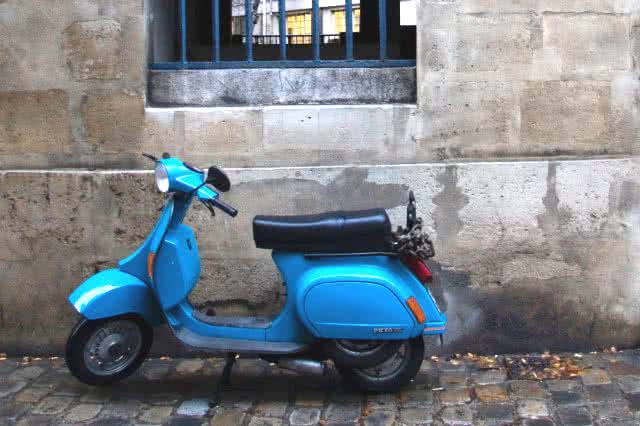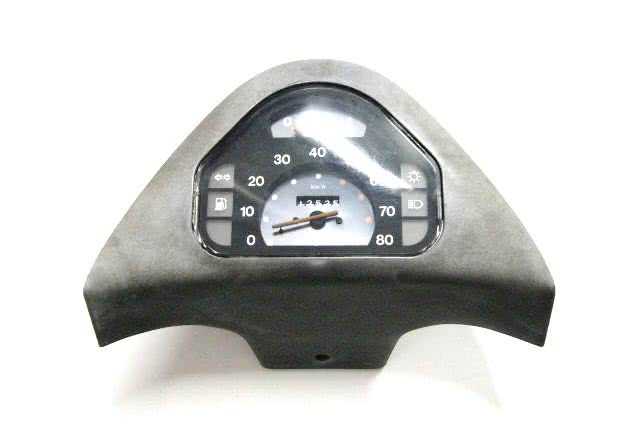Vespa PK
The Vespa PK 50 was a scooter built by Piaggio starting from the year 1983, with an engine capacity of 50 cm³. The production of the Vespa PK 50 lasted until the year 1996. Over four million units of this Vespa model were sold.
The PK 50 as an Evolution of the Smallframe
The newly developed Vespa PK 50 was visually different and significantly more angular compared to its predecessor, the Vespa 50. It was criticized upon market entry particularly for the shape of the side panels, the plastic handlebar cover, and, in the late PK 50 XL and XL2 models, for the numerous plastic parts on the seat frame, luggage compartment, rear cover, and the indicator holes inserted into the frame.
The changes to the side panels of the PK 50 brought advantages in terms of ergonomics and function compared to the V50. The modernized electrical system brought new components and required adjustments to the frame. The introduced spacer plate for the spare wheel bracket on the Vespa PK served as a mount for the electrical components needed from then on, such as indicator relays, horn rectifiers, or battery, voltage regulator, and starter relay. A spare wheel could also be carried from that point onwards under the left side panel and easily removed thanks to the removable left side cover. The change in the shape of the side panels also facilitated access to the engine. The improved space made working on the cylinder easier. With the Vespa PK, a cylinder change (short stroke) is possible even without lowering the engine.
Piaggio significantly redesigned the chassis of the Vespa PK 50 (excluding Italian PK models, which entered the market with a handlebar similar to the V50). The concept of the single-arm swingarm remained but was greatly improved. A modified angle on the front swingarm, the increased suspension travel, and the modified front axle significantly improved suspension and braking performance. This finally solved the problem of the front shock absorber bottoming out, which was sometimes unavoidable with the Vespa V50 despite the use of stiffer springs.
Vespa PK 50 S/XL/XL2 and 125 cc Model Overview:
The "PK 50" was the first Smallframe model from the "PK" series. The PK 50 was one of the models colloquially referred to as bread and butter models and had neither indicators, brake lights, nor a horn.
The 6V ignition system had a small 19/20mm cone like the Vespa 50 and a flywheel with an inner diameter of >100 mm. Piaggio changed the upper connecting rod bearing on the crankshaft. While the Vespa V50 still used a plain bearing, the crankshaft of the Vespa PK 50 with a small cone received a replaceable needle bearing. The needle bearing allowed the use of stronger tuning cylinders with 75 cc or even cylinders with more than 100 cc like the DR 102 or Malossi 102.
For the PK 50 frame, Dellorto built a carburetor with the suffix "F", which brought the mixture adjustment screw to a position more accessible in the Vespa PK 50.

The PK 50 S differed from the PK 50 by featuring a four-flash indicator system, a horn, a 12V ignition system, and a flywheel that still had the small 19/20mm cone but with an inner diameter of less than 100mm.
The rare PK 50 Lusso mainly differed from the PK 50 S in the modified handlebar cover.
The successor to the PK 50 S was the PK 50 XL, where Piaggio made various changes. In the engine, the crankshaft was changed to have a large cone with 20/20 mm. The intake manifold was attached via a 3-hole flange.

From then on, a Dellorto SHB 16.15F carburetor did the job as the carburetor. Changes to the frame included the luggage compartment, the upper handlebar cover, the seat, and the step strips, which were replaced by foot mats. The side covers received a fold and were opened via a cable below the seat. The horn moved behind the leg shield into the luggage compartment because the cascade, for aerodynamic reasons, tapered to a point in shape, and therefore no longer offered space for mounting the horn.

The PK 80 S and PK 100 S differed from the PK 50 S by having more displacement, a crankshaft with a longer stroke, a longer primary gear with a 1:2.86 ratio, and, like the PK 125, an SHBC 19.19 carburetor.
The particularly outstanding feature of the Vespa PK 125 ETS was the revised crankshaft. The ETS crankshaft is characterized by particularly high durability. The use of an ETS crankshaft in a normal Smallframe housing is possible by using a conversion bearing and conversion oil seal.
The Vespa PK 50 XL "Milka Edition" was a Vespa PK XL produced for a competition and another bread and butter model without indicators.
The PK 50 XL2, also available with 125 cm³, was the last Vespa with a manual gearbox. The significant differences in the XL2 engine were the revised clutch, the position and sealing of the shift fork, the steering head construction without a cast subframe, and shifting using a rigid shift wire. The speedometer on the XL2 was no longer round but triangular with rounded corners.

Both the Vespa PK 50 Plurimatik (VA51T) and the XL2 Automatic/Automatica (VA52T) were niche models and by no means as successful as the models with manual transmission. Unfortunately, the spare parts of the manual transmission models often cannot be used for the PK 50 XL Automatic. The automatic models can sometimes be easily distinguished from a Vespa PK with manual transmission by looking at the alternator-side engine half.
The XL2 for the Austrian market had some differences from all other PK XL2 models. The carburetor on the Austrian model was not from Dellorto but from "Bing Power Systems". In addition, a different crankshaft and a cylinder with direct inlet were installed. The inlet of the engine housing was closed.
Piaggio sold a version of the Vespa PK 50 XL in Italy as Vespa "50N", which sometimes led to confusion with the German V50, which in Germany is called "Vespa 50N". In Germany, this model was called "PK XL Rush". This Vespa scooter had a 3-speed gearbox, which also led to the name extension 3-marce. Other features included a plastic rear cover, a single-person sports seat, and confirmation of the gearbox using a shift wire.
The Italian HP4 was a scooter for the Italian market. The designation HP4 stood for High-Performance 4-marce, which means high performance with four gears (in contrast to the Rush). The higher performance was achieved by the powerful aluminum cylinder. To regulate the scooter according to traffic regulations despite the high performance of the cylinder, a throttled Dellorto SHB 16.12 carburetor with a corresponding intake manifold and a primary gear with a gear ratio of 1:4.93 were installed.
